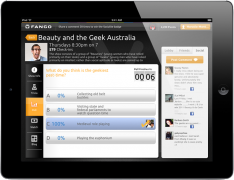TV companion apps
 In a feature that first appeared in Encore, Marcus Casey looks at the growing trend of TV companion apps and asks who is benefitting from the technology.
In a feature that first appeared in Encore, Marcus Casey looks at the growing trend of TV companion apps and asks who is benefitting from the technology.
Television companion apps have been hailed as the next big thing in the TV experience for some time now, and while there has been an impressive number of downloads – more than 2.5 million – of the existing ones in Australia, they haven’t quite pierced the wider public consciousness.
And it’s not really known just how many of those downloaders use these apps regularly as the operators – all of the commercial free-to-air networks excluding SBS – won’t reveal figures, even though the apps collect scores of data.
But there is a movement out there, and it’s growing. Encore has spoken to the operators and they insist the so-called ‘second screen’ experience on tablets and smartphones is already a success.


While I have no doubt the opportunity for second-screen integration is slowly growing bigger – I fail to see how it is already a success.
Fango says it has 700,000 downloads in what, a year or two? In that time they are just now approaching 2.5 mill check-ins..
So if my math is right, Fango has had an average of just 3 check-ins per user over a 1-2 year period!? How is that success? I change phones completely more times in a 2 year period than that.
None of the current major players are making much headway. Firstly this is not for everyone – only for people that love love ‘specific’ TV shows. Secondly, penetration of ‘tech savviness’ across mainstream commercial channel viewers does not compare to UK or Europe. Thirdly, media partisanship is more entrenched in AUS than in UK or Europe. Have a look at US second screen engagement – it is poor. I think locally all three players in the market are doing a comparably good job.
Zeebox has a far superior user experience in comparison to JumpIn and Fango. Faster, simpler and makes social engagement simple while watching TV – easier that looking up a hashtag! I’m a convert.
I have been using a website called GetGlue for the past year now, which allows you to check into TV Shows. It was probably the first website / app of this sort, and is targeted towards the United States, not Australia. You get a lot more satisfaction checking into GetGlue, as a lot of shows that you check-in to, have show specific stickers that you can unlock, many of them only being available for a limited amount of time.
Services like Fango and Zeebox do not do this, which makes them a bit more boring. Fango is also maintained by Channel 7, and Zeebox is maintained by Channel 10, which means that both of the apps are biased towards the respective networks, if that makes sense. That is simply not the case with GetGlue. One of the other reasons that I use GetGlue, is to keep track of how much TV I am watching. I could go and check my account right now, and know exactly how many South Park episodes I have watched since I started using the service. This is a pretty cool stat to know, lol.
In conclusion, GetGlue has a far superior implementation of the concept, compared to Fango and Zeebox. It is not owned by a television network, and is therefore unbiased. You can unlock show specific stickers, which may only be available for a limited amount of time, and there are apps for both the iPhone and iPad, Android, and there is the standard and mobile website.
Has Jump In actually relaunched? Just checked it on my iPad and it seems to still be the worst app out there by some margin.I don’t have an update available, though I may have updated it in an ‘Update All’ recently.
Cannot spot any difference though. Terrible.